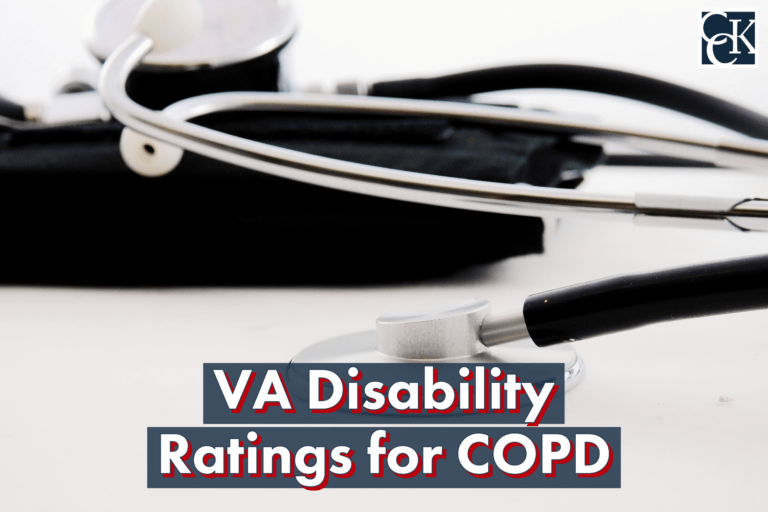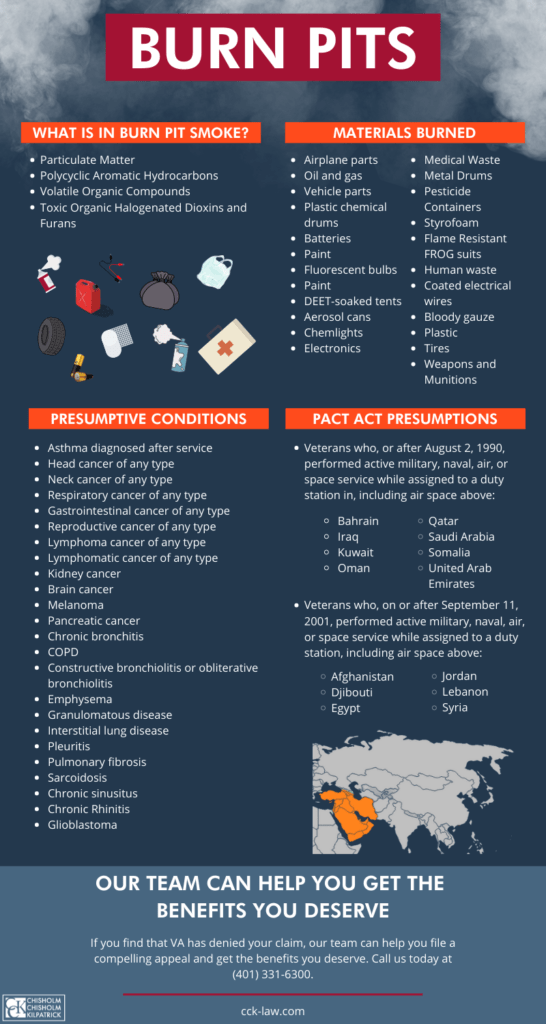VA Disability Ratings for COPD

CCK Law: Our Vital Role in Veterans Law
Chronic Obstructive Pulmonary Disease (COPD) is an inflammatory lung disease that causes obstructive airflow to and from the lungs. Symptoms of COPD include coughing, difficulty breathing, wheezing, tightness of the chest, and frequent respiratory infections. COPD is often referred to as chronic bronchitis or emphysema. However, a person can have symptoms of both, or, for example, have symptoms of COPD and not bronchitis.
What Causes COPD?
Chronic obstructive pulmonary disease can be caused by exposure to harmful gases or particulate matter, such as sand and dust. Veterans who served in Iraq and Afghanistan after September 11, 2001 may have been exposed to burn pits, open-air pits used on U.S. military bases to burn waste. Servicemembers exposed to the hazardous chemicals released by these burn pits may experience severe respiratory conditions after service, including COPD.
Service Connection for COPD
Veterans seeking service connection for COPD will likely be service connected on a direct basis. Direct service connection requires veterans to meet three criteria. Veterans must have:
- A current diagnosis;
- An in-service event, injury, or illness; and
- A medical “nexus” linking the in-service occurrence to their current diagnosis.
How Does VA Rate COPD?
VA rates COPD based on the results of respiratory functioning tests, such as Forced Expiratory Volume in 1 Second (FEV-1), the ratio of FEV-1 to Forced Vital Capacity (FCV), the Diffusion Capacity of the Lung for Carbon Monoxide by the Single Breath Method (DLCO (SB)), and exercise testing.
FEV-1 is the maximum amount of air that a person can breathe out in 1 second. FEV-1 is measured against the FEV-1 for a normal person of your size and age.
FCV is the total amount of air that a person can exhale after taking a full breath in. Similar to FEV-1, it is expressed in a percentage of the average person similar to you.
DLCO (SB) measures the ability of a person’s lungs to transfer gas from air that is inhaled to their red blood cells. The test measures this by comparing how much carbon monoxide is left when a person exhales to how much they inhaled. This measurement is then measured against that of a normal, average person.
Exercise testing determines show much oxygen a person’s blood uses when they are functioning at maximum capacity, meaning the maximum amount of physical activity that the person can repeat and sustain. This measure is expressed in the amount of oxygen used by your body weight per minute.

VA Rating Schedule for COPD
VA rates COPD under 38 C.F.R. 4.97, diagnostic code 6604. Ratings range from 10 to 100 percent disabling and are meant to compensate veterans for the lack of earning capacity caused by their condition.
The 10 percent rating for COPD requires that a veteran have one of the following:
- FEV-1 of 71 to 80% predicted, or;
- FEV01/FVC of 71 to 80% or;
- DLCO (SB) of 66 to 80% predicted
The 30 percent rating for COPD requires:
- FEV-1 of 56 to 70% predicted, or;
- FEV-1/FVC of 56 to 70%, or;
- DLCO (SB) of 56 to 65% predicted
The 60 percent rating for COPD requires:
- A FEV-1 of 40 to 55% predicted, or;
- FEV-1/FVC of 40 to 55%, or; DLCO (SB) of 4 to 55% predicted, or;
- Maximum oxygen consumption of 15 to 20 ml/kg/min (with cardiorespiratory limit)
Finally, the 100 percent rating for COPD requires that a veteran have one of the following:
- FEV-1 less than 40% predicted
- FEV-1/FVC less than 40%
- DLCO (SB) less than 40% predicted
- Maximum exercise capacity less than 15 ml/kg/min oxygen consumption
- Right heart failure
- Right ventricular hypertrophy
- Pulmonary hypertension shown by Echo or cardiac catheterization
- Episodes of acute respiratory failure
- Require outpatient oxygen therapy
NOTE: Veterans can only be rated for one respiratory condition. For instance, if a veteran has COPD and asthma that they believe was caused by service, they can only receive VA disability benefits for one of them.
Military Burn Pit Exposure and COPD
COPD is just one of the conditions that have been linked to military burn pit exposures. Many veterans who were exposed to military burn pits during their military service have gone on to develop COPD.

What are Military Burn Pits?
Military burn pits are large areas of land in which the military and its contractors incinerated all waste generated by military bases, including plastics, medical waste, rubber, human waste, etc.
The U.S. military used burn pits as part of their waste disposal protocol in places such as Iraq and Afghanistan in the post-9/11 era during Operations Iraqi and Enduring Freedom. While the practice was effective in reducing large quantities of waste, burn pits emitted plumes of toxic smoke. This was especially problematic in places such as the Middle East, where the desert wind carried the smoke for miles.
Many U.S. military veterans have suffered health consequences from burn pit exposure. Most of the negative effects involve temporary ailments of the respiratory system, though limited evidence suggests a link between burn pit exposure and the long-term deterioration of lung health.
When and Where Were Burn Pits Used?
Veterans who served in any of the following military operations since September 11, 2001 may have been exposed to burn pits:
- Operation Iraqi Freedom
- Operation Enduring Freedom
- Operation New Dawn
Research continues to be done to link burn pit exposure to a variety of different conditions, such as cancers and respiratory illnesses. In order to fully understand the harm caused by military burn pits, further research will need to be conducted. However, research has indicated that one of the known chemical compounds released by burn pits includes the dioxin called TCDD which was also found in Agent Orange.

New Particulate Matter Presumption
As of August 2, 2021, VA began processing disability claims for asthma, rhinitis, and sinusitis on a presumptive basis based on presumed particulate matter exposures. Veterans who served in Southwest Asia and other specified areas and manifested asthma, rhinitis, or sinusitis within 10 years of a qualifying period of military service may be eligible. Many veterans exposed to burn pits during their service and developed one of these three conditions may be able to seek service connection under this new presumption.
Specifically, the presumption impacts veterans who served in Afghanistan, Uzbekistan, Syria, or Djibouti between September 19, 2001 and the present day. It also encompasses veterans who served between August 2, 1990 and the present in the Southwest Asia theater of operations. The Southwest Asia theater of operations refers to the following areas:
- Iraq
- Kuwait
- Saudi Arabia
- The neutral zone between Iraq and Saudi Arabia
- Bahrain
- Qatar
- The United Arab Emirates
- Oman
- Gulf of Aden
- Gulf of Oman
- Persian Gulf
- Arabian Sea
- Red Sea
- The airspace above all these locations
Honoring Our PACT Act
In August of 2022, the Honoring Our PACT Act created a presumption of exposure for veterans who may have been exposed to bun pits during their military service. In order to be eligible for this presumption, the veteran needs to have served:
- On or after August 2, 1990, with active military, naval, air, or space service while assigned to a duty station, including the airspace above:
- Bahrain
- Iraq
- Kuwait
- Oman
- Qatar
- Saudi Arabia
- Somalia
- United States Emirates
- On or after September 11, 2001, with active military, naval, air, or space service while assigned to a duty station, including the airspace above:
- Afghanistan
- Djibouti
- Eqypt
- Jordan
- Lebanon
- Syria
- Yemen
- Uzbekistan
If you have been diagnosed with COPD following your service in one of the above-mentioned locations and time periods, then you may be eligible for presumptive service connection. Presumptive service connection means that the burden of proof to prove the connection between COPD and burn pit exposure is not on the veteran.
Denied VA Disability Benefits for COPD?
Veterans’ disability claims are often denied, but a denial does not mean the end of the road. Our experienced VA disability attorneys may be able to help you secure VA disability benefits for COPD. Contact our office today for a free consultation at (800) 544-9144.
About the Author
Share this Post
